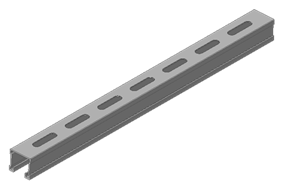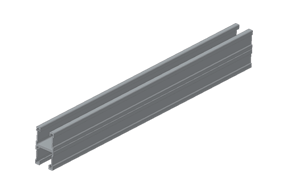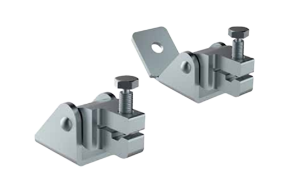Trapeze Support (Single or Multi-tier)
Hanger rod clamps, “J” hangers
Center Hung Support
Wall Support
Underfloor Support
Pipe stanchions or other structures
Each of these support methods are preferable in different applications. For instance, trapeze supports may be desired in an application where cables will be pulled through the cable tray. Center hung supports, on the other hand, are generally used when cables will be installed from the side of the cable tray. Center hung supports are
especially useful when future cable additions are desired. Wall supports and underfloor supports are useful when ceiling structure is not available or undesired. Outdoor installations are controlled by the structures available to support the cable tray.
Support
Popular Products
-
Q What support methods are available?
-
Q What types of Cable Tray are available?
Solid Cable Tray
Perforated Cable Tray
Ladder Cable Tray -
Q Now that I know what types of cable trays are available, what configurations are available?
Straight sections are available to route cables in a horizontal or vertical plane. Fittings are available to route cables in various directions in either the horizontal or vertical planes. Typical examples of fittings include bends, tees, crosses,reducers, and risers. Each of these fittings are available in various radii and bend angles. Covers are accessories and shouldn’t be in here unless splices etc. are included.
-
Q What materials / finishes are available for the various cable tray systems?
Steel (Min. Yield = 33KSI)
Plain: hot rolled pickled and oiled steel per ASTM A569 (Commercial Quality) or A570 (Structural Quality)
Pre-Galvanized: mill galvanized steel per ASTM A653 CS (Commercial) or SS (Structural) G90
Hot Dip Galvanized After Fabrication: plain steel which is hot dipped after fabrication per ASTM A123.Stainless Steel: (Min. Yield = 35KSI)
type201 or 304 or 316L fully annealed stainless steelAluminum: (Min.Yield = 23 KSI)
6063-T6 or 5052-H32 alloy per ASTM B209 -
Q How do I know what type of cable tray is right for my application?
Solid Cable Tray provides:
Nonventilated continuous support for delicate cables with added cable protection available in metallic and fiberglass.
Solid bottom metallic with solid metal covers for nonplenum rated cable in environmental air areas
Standard widths of 6, 12, 18, 24, 30, and 36 inches
Standard depths of 3, 4, 5, and 6 inches
Standard lengths of 10, 12, 20 and 24 feet
Solid Bottom cable tray is generally used for minimal heat generating electrical or telecommunication applications with short to intermediate support spans of 5 feet to 12 feet.Perforated Cable Tray provides:
Moderate ventilation with added cable support frequency and with the bottom configuration providing cable support every 4 inches. Available in metal and nonmetallic materials.
Standard widths of 6, 12, 18, 24, 30, 36 inches
Standard depths of 3, 4, 5, and 6 inches
Standard lengths of 10, 12, 20 and 24 feet
Fixed rung spacing of 4 inch on center
Ventilated Cable Tray is generally used for moderate heat generating applications with short to intermediate support spans of 5 feet to 12 feet.Ladder Cable Tray provides:
Solid side rail protection and system strength with smooth radius fittings and a wide selection of materials and finishes.
Maximum strength for long span applications
Standard widths of 2,3,4,6,8,12,16,20,24,32,40,48 inches
Standard depths of 1,2,3,4,6,8 inches
Standard lengths of 80 inches
Rung spacing of 10 inches
Ladder cable tray is generally used in applications with intermediate to long support spans, 12 feet to 30 feet. -
Q What standards / guidelines are available for cable tray systems?
The National Electrical Code publishes the standards for all types of electrical applications. Articles 318, 250, and 800 cover various aspects of cable tray systems.
NEMA, (National Electrical Manufacturers Association), is an association comprised of the major cable tray manufacturers in the industry. This committee has published three documents to date: NEMA VE1, FG1 and VE2.
NEMA VE1 covers general cable tray definitions, manufacturing standards, performance standards, test standards, and application information. Free download of this document is available on the NEMA website.
NEMA FG1 addresses the standards for fiberglass cable tray systems. Free download of this document is available on the NEMA website.
NEMA VE2 is a cable tray installation guideline which covers receiving and unloading material, storage of material, and general installation practices. Free download of this document is available on the NEMA website.
CTI, (Cable Tray Institute), is a trade association comprised of the major cable tray manufacturers in the industry and was formed to provide specifiers, designers, and installers information on the advantages of using cable tray systems over other types of products. (i.e. conduit, ladder rack, etc.)
-
Q What is a Cable Tray System?
Per the National Electrical Code, a cable tray system is “a unit or assembly of units or sections and associated fittings forming a rigid structural system used to securely fasten or support cables and raceways.”
What does this mean?
Cable trays support cable the way that roadway bridges support traffic.
A bridge is a structure that provides safe passage for traffic across open spans.
Cable tray is the bridge that allows for safe transport of wires across open spans.
Therefore, think of cable tray as the structural component of a building’s electrical system.




 Strut Channel
Strut Channel Back to Back Strut Channel
Back to Back Strut Channel Connecting Base Fitting
Connecting Base Fitting


